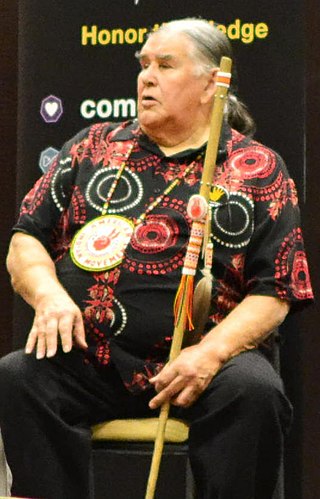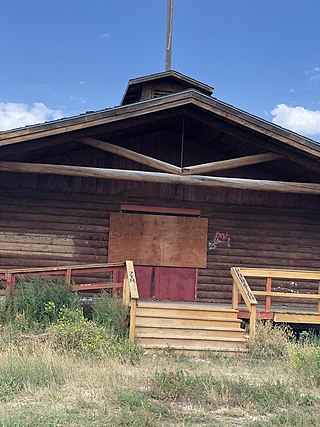
Wounded Knee is a census-designated place (CDP) on the Pine Ridge Indian Reservation in Oglala Lakota County, South Dakota, United States. The population was 364 at the 2020 census.

The American Indian Movement (AIM) is an American Indian grassroots movement which was founded in Minneapolis, Minnesota in July 1968, initially centered in urban areas in order to address systemic issues of poverty, discrimination, and police brutality against American Indians. AIM soon widened its focus from urban issues to many Indigenous Tribal issues that American Indian groups have faced due to settler colonialism in the Americas. These issues have included treaty rights, high rates of unemployment, the lack of American Indian subjects in education, and the preservation of Indigenous cultures.

The Pine Ridge Indian Reservation, also called Pine Ridge Agency, is an Oglala Lakota Indian reservation located in the U.S. state of South Dakota, with a small portion of it extending into Nebraska. Originally included within the territory of the Great Sioux Reservation, Pine Ridge was created by the Act of March 2, 1889, 25 Stat. 888. in the southwest corner of South Dakota on the Nebraska border. It consists of 3,468.85 sq mi (8,984 km2) of land area and is one of the largest reservations in the United States.

Russell Charles Means was an Oglala Lakota activist for the rights of Native Americans, libertarian political activist, actor, musician and writer. He became a prominent member of the American Indian Movement (AIM) after joining the organization in 1968 and helped organize notable events that attracted national and international media coverage.

Dennis Banks was a Native American activist, teacher, and author. He was a longtime leader of the American Indian Movement, which he co-founded in Minneapolis, Minnesota in 1968 to represent urban Indians. He was a pre-eminent spokesman for Native Americans. His protests won government concessions and created national attention and sympathy for the oppression and deplorable endemic social and economic conditions for Native Americans.

Clyde Howard Bellecourt was a Native American civil rights organizer. His Ojibwe name is Nee-gon-we-way-we-dun, which means "Thunder Before the Storm". He founded the American Indian Movement (AIM) in Minneapolis, Minnesota, in 1968 with Dennis Banks, Eddie Benton-Banai, and George Mitchell. His elder brother, Vernon Bellecourt, was also active in the movement.

Frank Fools Crow was an Oglala Lakota civic and religious leader. 'Grandfather', or 'Grandpa Frank' as he was often called, was a nephew of Black Elk who worked to preserve Lakota traditions, including the Sun Dance and yuwipi ceremonies. He supported Lakota sovereignty and treaty rights, and was a leader of the traditional faction during the armed standoff at Wounded Knee in 1973. With writer Thomas E. Mails, he produced two books about his life and work, Fools Crow in 1979, and Fools Crow: Wisdom and Power in 1990.

The Wounded Knee Occupation, also known as Second Wounded Knee, began on February 27, 1973, when approximately 200 Oglala Lakota and followers of the American Indian Movement (AIM) seized and occupied the town of Wounded Knee, South Dakota, United States, on the Pine Ridge Indian Reservation. The protest followed the failure of an effort of the Oglala Sioux Civil Rights Organization (OSCRO) to use impeachment to remove tribal president Richard Wilson, whom they accused of corruption and abuse of opponents. Additionally, protesters criticized the United States government's failure to fulfill treaties with Native American people and demanded the reopening of treaty negotiations to hopefully arrive at fair and equitable treatment of Native Americans.
Richard A. Wilson was elected chairman of the Oglala Lakota of the Pine Ridge Indian Reservation in South Dakota, where he served from 1972–1976, following re-election in 1974.

Incident at Oglala is a 1992 American documentary film directed by Michael Apted and narrated by Robert Redford. The film documents the deaths of two Federal Bureau of Investigation agents, Jack R. Coler and Ronald A. Williams, on the Pine Ridge Indian Reservation on June 26, 1975. Also killed in the multiple fire was Native American Joe Stuntz, a member of the American Indian Movement (AIM), whose death prompted no legal action.

The Red Power movement was a social movement led by Native American youth to demand self-determination for Native Americans in the United States. Organizations that were part of the Red Power Movement include the American Indian Movement (AIM) and the National Indian Youth Council (NIYC). This movement sought the rights for Native Americans to make policies and programs for themselves while maintaining and controlling their own land and resources. The Red Power movement took a confrontational and civil disobedience approach to inciting change in United States to Native American affairs compared to using negotiations and settlements, which national Native American groups such as National Congress of American Indians had before. Red Power centered around mass action, militant action, and unified action.

The Oglala are one of the seven subtribes of the Lakota people who, along with the Dakota, make up the Očhéthi Šakówiŋ. A majority of the Oglala live on the Pine Ridge Indian Reservation in South Dakota, the eighth-largest Native American reservation in the United States.

The Guardians of the Oglala Nation (GOON) was an American paramilitary group established in 1972 by Oglala tribal chairman Dick Wilson under authority of the Oglala Sioux Tribal Council. It operated on the Pine Ridge Indian Reservation during the early 1970's, and was disbanded after a new chairman was elected in 1976.
Leonard Crow Dog was a medicine man and spiritual leader who became well known during the Lakota takeover of the town of Wounded Knee on the Pine Ridge Indian Reservation in South Dakota in 1973, known as the Wounded Knee Incident. Through his writings and teachings, he has sought to unify Indian people of all nations. As a practitioner of traditional herbal medicine and a leader of Sun Dance ceremonies, Crow Dog was also dedicated to keeping Lakota traditions alive.
Gladys Bissonette, "the brave–hearted woman of Wounded Knee", was an Oglala Lakota elder who was one of the leaders of the traditional faction during the violent turmoil on the Pine Ridge Indian Reservation during the 1970s. Dick Wilson became Tribal Chairman in 1972 and began a "reign of terror" on the reservation. Wilson favored mixed–blood residents and close family and friends for positions in his office and created a special enforcing unit, known as the "Goon Squad", to police the region. This Goon Squad soon began to terrorize the residents of the reservation who openly spoke out against Wilson or disagreed with him, especially those who were pure–blooded Indians. Many attempts were made at impeaching Wilson, but Wilson always interfered and subsequently kept his position by sending out his Goon Squad to stamp out the residents who dared try to impeach him. "The past administrations all along have been pretty sly and crooked with Indian funds," said Gladys, "but they weren't quite as hard on us as this drunken fool we got now."
Perry Ray Robinson was an African American activist from Alabama during the civil rights movement. He had been active in Mississippi and Washington, D.C., supporting the March on Washington and the Poor People's Campaign. Robinson disappeared while participating in the 1973 American Indian Movement (AIM) resistance in the Wounded Knee incident on the Pine Ridge Indian Reservation in South Dakota.
Madonna Thunder Hawk is a Native American civil rights activist best known as a leader in the American Indian Movement (AIM) and as an organizer against the Dakota Access Pipeline. She co-founded the American Indian organization Women of All Red Nations and serves as the Director of Grassroots Organizing for the Red Road Institute.
Lorelei DeCora Means is a Native American nurse and civil rights activist. She is best known for her role in the second siege in the town of Wounded Knee, South Dakota, on the Pine Ridge Indian Reservation. She was also a co-founder of the American Indian organization, Women of All Red Nations.
Edgar Donroy Bear Runner was a Native American activist. He is perhaps best known for attempting to peacefully negotiate the Jumping Bull ranch incident in 1975 via parleying with American Indian Movement activists.
Darlene Nichols, also known by the names Kamook, Ka-Mook, Kamook Nichols and Ka-Mook Nichols, is the name of a former AIM member and Native American protester. She is best known for her role in the American Indian Movement for organizing The Longest Walk, and for serving as a key material witness in the trials of Arlo Looking Cloud, Richard Marshall, and John Graham that ultimately led to the conviction of two AIM members in the murders of Anna Mae Aquash.












